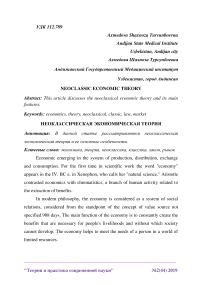Neoclassic economic theory
Автор: Axmedova Sh.T.
Журнал: Теория и практика современной науки @modern-j
Рубрика: Основной раздел
Статья в выпуске: 2 (44), 2019 года.
Бесплатный доступ
This article discusses the neoclassical economic theory and its main features.
Economics, theory, neoclassical, classic, law, market
Короткий адрес: https://sciup.org/140274323
IDR: 140274323
Текст научной статьи Neoclassic economic theory
Economic emerging in the system of production, distribution, exchange and consumption. For the first time in scientific work the word "economy" appears in the IV. BC e. in Xenophon, who calls her "natural science." Aristotle contrasted economics with chrematistics, a branch of human activity related to the extraction of benefits.
In modern philosophy, the economy is considered as a system of social relations, considered from the standpoint of the concept of value source not specified 908 days. The main function of the economy is to constantly create the benefits that are necessary for people's livelihoods and without which society cannot develop. The economy helps to meet the needs of a person in a world of limited resources.
Neoclassical economic theory originated in the 1870s. Representatives: US Jevons and L. Walras (mathematical school), J. B. Clark (American school), Irving Fisher, A. Marshall and A. Pigou (Cambridge school).Neoclassical direction investigated the behavior of the so-called. an economic person (consumer, entrepreneur, employee) who seeks to maximize income and minimize costs. The main categories of analysis are marginal values (see Marginalism).
Neoclassical economists have developed a theory of marginal productivity, the theory of general equilibrium, according to which the mechanism of free competition and market pricing provides a fair distribution of income and the full use of economic resources, economic theory of welfare, the principles of which are the basis of the modern theory of public finance (P. Samuelles), theory rational expectations, etc.In the second half of the XIX century, along with Marxism, neoclassical economic theory arose and developed. Of all its numerous representatives, the English scientist Alfred Marshall (1842-1924) has become the most famous. He was a professor, head of the department of political economy at the University of Cambridge.
Economic growth is defined as the increase in real production in the national economy for a certain period of time (for a month, quarter, year). Unlike economic development, economic growth is a quantitative indicator. Real production is usually understood as real (that is, cleared of inflation factors) gross domestic product (GDP), less commonly real gross national product (GNP), net national product (NNP), or national income (ND). Economic growth is closely linked to an increase in overall well-being: an increase in life expectancy, quality of care, level of education, reduction in working hours, etc.There are extensive and intensive factors of economic growth.
A. Marshall summarized the results of new economic research in the fundamental work "Principles of Economic Theory" (1890).In his works, A.
Marshall relied both on the ideas of classical theory and on the ideas of marginalism. Marginalism (from English marginal - marginal, extreme) is a trend in economic theory that emerged in the second half of the XIX century. Marginal economists in their studies used marginal values, such as marginal utility (utility of the latter, an additional unit of benefit), marginal productivity (products produced by the last employee employed).They used these concepts in price theory, wage theory, and in explaining many other economic processes and phenomena.In his theory of prices, A. Marshall relies on the concepts of supply and demand. The price of the good is determined by the ratio of supply and demand.
In primitive society, the level of economic development was low, ensuring consumption on the verge of physical survival. At first, primitive people earned their livelihood through hunting and gathering, but as a result of the Neolithic revolution, agriculture and animal husbandry arose. The development of society led to a division of labor — agricultural and shepherd tribes stood out, artisans stood out, the first of whom were blacksmiths. Appeared social inequality, social classes and the state. There was slavery.
The basis of the demand for the benefit lies in the subjective assessment of the marginal utility of the benefit by consumers (buyers). At the heart of the supply of benefits are the costs of production. A manufacturer cannot sell at a price that does not cover its production costs.
If classical economic theory considered price formation from the standpoint of a producer, then neoclassical theory considers pricing both from the standpoint of the consumer (demand) and from the standpoint of the producer (suggestion).Neoclassical economic theory, like classical political economy, proceeds from the principle of economic liberalism, the principle of free competition.
But in their studies of neoclassicism, they place greater emphasis on the study of applied practical problems, using quantitative analysis and mathematics rather than qualitative (meaningful, causal). The greatest attention is paid to the problems of efficient use of limited resources at the microeconomic level, at the enterprise and household levels. Neoclassical economic theory is one of the foundations of many areas of modern economic thought.
Used sources:
Список литературы Neoclassic economic theory
- Blaug M. Neoclassical theory of money, interest and prices // Economic thought in retrospect = Economic Theory in Retrospect. - M.: Delo, 1994. - p. 586-606. - XVII, 627 p. - ISBN: 5-86461-151-4
- Neoclassical direction / G. D. Gloveli // The Great Russian Encyclopedia: [in 35 t.] / Ch. ed. Yu. S. Osipov. - M.: The Great Russian Encyclopedia, 2004-2017.


